Convenience for Movable Lives
Like palace hotel life, midpriced hotel life began in the early 1800s. In the young Chicago of 1844, about one person in six listed in the city directory lived in a hotel, and another one in four lived in a boardinghouse or with an employer.[2] Walt Whitman reported in 1856 that almost three-fourths of middle and upper class New Yorkers were either
boarders or permanent hotel guests. When Whitman asked one little girl where her parents lived, she answered instructively, "They don't live; they BOARD."[3] Through the 1890s, visiting writers from London emphasized that (compared to the English) many more Americans could buy a modest house of their own but preferred to live in boardinghouses and hotels. American writers concurred. One remarked about the "temptation to live in hotels instead of in apartment houses." In 1919, the sociologist Arthur Calhoun explained that hotel life might begin in a couple's youth and continue through their mature years or be resumed after a period of housekeeping. He wrote that "almost any family, even the wealthiest, might at some time try this manner of life."[4]
Immediate Places for New Job Holders
The occasional shortage of single-family houses in rapidly growing cities was one factor that sent middle-income families who were new to a city to a hotel. House prices and mortgage terms were high. Also, from 1870 to the 1920s, the building of new suburban houses did not consistently match demand. Families waiting for a house often lived in a hotel for a year or more. In 1880, the family of San Francisco stockbroker Daniel Stein (including his daughter Gertrude Stein) lived for over a year in a suite in a commodious wooden hotel in Oakland while they waited to move a dozen blocks away into a suburban house with a ten-acre garden (fig. 3.1).[5]
Temporary jobs created other middle-income hotel dwellers. From the Civil War through World War II, people in rapidly expanding business markets were often sojourners. The expansion of trade and railroad links throughout the United States opened thousands of white-collar positions in manufacturing, marketing, and managing chain store and branch store businesses. Engineers, accountants, lawyers, and other professionals flocked to assist these new operations.[6] Many people very tentatively began their stay in a new company or city; they expected to live there only for a period of a few months to two or three years. Such sojourners made up a significant share of the permanent residents in midpriced hotels, and their initial visit often stretched into lifelong hotel residence.
Epitomizing the sojourner household were Mr. and Mrs. Walters, a couple interviewed in the 1920s. They had lived in hotels in small cities near Chicago for a succession of years. In each place, Mr. Walters spent
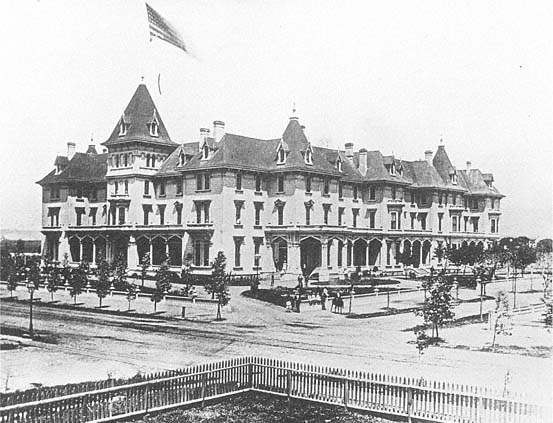
Figure 3.1
The Tubbs Hotel in suburban Oakland, soon after its opening in 1871. Gertrude Stein's family lived here
while waiting for completion of their house two miles away.
four or five months establishing a branch sales department for electrical appliances; then he placed a sales person in charge and moved to another town.[7] Similarly, construction projects required experts who stayed for months or years of planning and building. Architects flocked to cities after major fires, then moved on a few years later. It was not unusual for sojourning architects to live in hotels; in a few cases, they also set up offices in the same building. Louis Sullivan's life was not as peripatetic as some of his lesser-known colleagues, but the famous architect lived in hotels much of his life.[8] Because of their centrality, hotels made ideal temporary office sites. In certain midpriced hotels, traveling sales people set up temporary offices in sample rooms purposely built and reserved for the display of wares. Some business people rented rooms in a residential hotel in the winter simply to avoid cold-weather commuting from their houses in distant suburbs. People serving on temporary government or business committees also relied on hotels in the midprice range.[9]
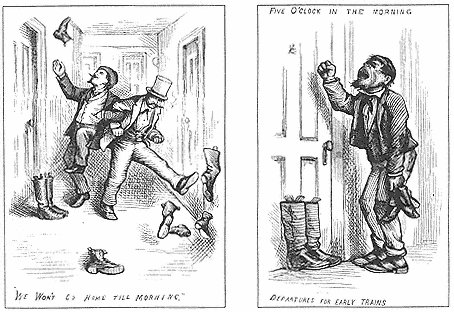
Figures 3.2 and 3.3
The problem of hotel noise, 1871. The Harper's Weekly cartoonist Thomas Nast
emphasized the risks of hallway interruptions especially where permanent
residents were not separated from tourist rooms.
For sojourners in a new city, moving into a hotel simplified the housing search. Hotels required commitments of only a month (at most), rather than the long-term leases required of apartment and house renters. Another inherent advantage of hotel life was avoiding the packing and lugging of household goods and large pieces of furniture. As one hotel observer put it, when a family had to move frequently, "even a large wardrobe is a nuisance, and a collection of furniture would be as appropriate as a drove of elephants."[10]
Like palace hotel residents, residents in midpriced hotels were well positioned to weave themselves into the social groups they needed for their work or personal ambitions. Hotels combined central location, maximum information availability, and high potentials for human contact with influential people of the middle and upper class. Hotel lobbies and dining rooms—in the early nineteenth century the official stock exchanges in many cities (and official slave markets in the South)—were alive with business and gossip. In other hotels, informal and openended social groups formed around billiards, dice, and card tables. In the 1920s, one young hotel resident wrote that her businessman father fortuitously met many other men of affairs in the lobby and in the smoke-filled billiards room after dinner.[11] Not all social aspects of hotel life were positive, but for a distinct minority of households, the advantages outweighed the problems (figs. 3.2, 3.3).
Assists for Politicians and Young Couples
Given these virtues of centrality, sojourning politicians naturally made up a significant hotel residence group. Through the 1800s, each urban political party patronized a particular hotel, and politicians to this day often live in capital city hotels while legislatures are in session. When owners tore down the old Neil House in Columbus, Ohio, President Warren Harding wrote to the managers saying that the hotel had been the "real capitol" of the state. Huey Long maintained a suite at the elegant Fairmont Hotel in New Orleans, spending so much time there that Louisiana lore suggests that he built State Highway 61 from the state capitol directly to the door of the hotel for his own convenience.[12] The most famous hotel-dwelling politician was Calvin Coolidge. The thrifty Coolidge and his wife were very long term hotel tenants. They lived many years in a dollar-a-day room in the old Adams House of Boston (built in 1883). When Coolidge was elected governor of Massachusetts in 1918, on the advice of friends he moved into a $2-a-day room. In 1921, Vice President and Mrs. Coolidge moved into the same modest fourth-floor corner suite in the Willard Hotel that Vice President and Mrs. Thomas R. Marshall had occupied throughout Marshall's second term in the Wilson administration. In 1922, a Washington hostess tried unsuccessfully to establish a pretentious vice-presidential house. Coolidge himself quelled the move, saying that maintaining such a residence on a $12,000-a-year salary was out of the question. The Coolidges remained in their Willard Hotel suite.[13] More recently, Supreme Court Justices Felix Frankfurter and Earl Warren have lived in hotels.[14] For most of 1931 to 1934, early in his career in Congress, Lyndon Johnson lived at the Dodge Hotel in Washington, D.C. During the early years of the Reagan administration, Attorney General William French Smith and Secretary of Defense Caspar Weinberger settled at the Jefferson Hotel.[15]
Newlyweds often lived in hotels. In the last half of the 1800s, people considered it unremarkable when a young couple lived the first two or three years of their marriage in a good boardinghouse or hotel. Such a life could be just as respectable as residence in a private house. In 1879, Sala noted that American married couples lived in fine hotels "by the half-dozen years together." Young married couples made up the mainstay of the guests in many expensive hotels, and teenage wives became the most numerous female residents.[16] At least until the 1890s, young well-to-do and middle-income brides often relied heavily on hotel so-
ciability. In a time when the median age for women at marriage was twenty-two to twenty-four years, younger brides could move into a hotel and enjoy the familiar routine of courting days and the company of young friends. They could spend a major part of their days visiting one another in their rooms or in the public parlors, either mimicking the formal visiting of residential neighborhoods or merely gossiping. According to the social historian Robert Elno McGlone, the conviviality of hotel life relieved women's fears of "early fading" or being "laid upon the shelf," phenomena they saw in many hardworking young wives and mothers who toiled at keeping house. For wives whose husbands traveled a great deal, hotel sociability also made life less lonesome than life alone in a house or an apartment.[17]
Young couples or single people—especially those accustomed to a high standard of living in their parents' homes—could more easily match or improve those standards by living in a palace hotel or midpriced hotel than by buying the expensive furnishings for a private house. Up to the 1890s, there were apartments for the very rich but a less ready supply of socially respectable apartments geared to middle incomes. Hotel managers catered to these desires for an impressive domicile; the plush furnishings in a good midpriced hotel could cost about half as much as the building itself. A traveler in 1855 observed that the better boardinghouses and almost all hotels were "furnished in a far more costly manner than a majority of young men can afford"—in fact, a life-style that would have cost twice as much in an individual household. This continued to be true into the 1920s. In 1926, a conservative estimate for the cost of complete furnishings for a professional person's household, with no servant and only an upright piano as an extravagance, totaled $5,000.[18] Such an initial cost, spread out in monthly rentals, bought far more sumptuous surroundings in a hotel.
Monthly rental costs in a midpriced hotel were usually one-half to one-third the rates at palace hotels. A Chicago sociologist, Norman Hayner, compared costs in the mid-1920s and found that a single room with bath at a midpriced hotel usually ranged from $40 to $60 a month. Hotel managers almost never advertised or divulged monthly rents charged to tenants, since they were individually negotiated. For permanent guests, monthly rates were always less than four times the weekly rate; sometimes they were only two weeks' rent for a month of occupancy.[19] For single people who did not have a servant or a family
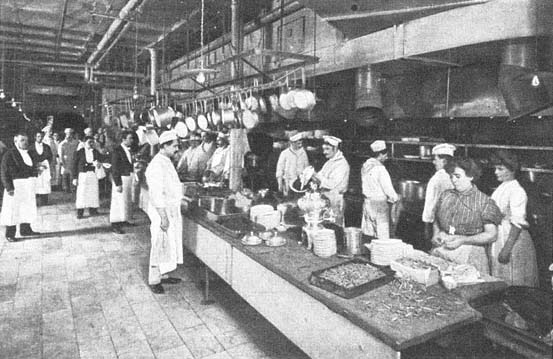
Figure 3.4
The core of cooperative housekeeping. A hotel's kitchen and serving staff pictured in Cosmopolitan
in 1905.
member to perform food preparation and housework, these prices were a bargain. As late as 1909, social workers admitted that it "nearly always" cost more "time, effort, and money to live well in suburbs than in town." Three Chicago schoolteachers explained to Hayner that separately they had been paying $6 or more per week for rooms with individual families. By pooling their rent money for a large room in an elegant midpriced hotel, they each saved a dollar a week and lived far more conveniently and convivially.[20]
New Household Roles for Women
Cooperative housekeeping was the hotel attraction appreciated most by middle-income people. None of the men in hotels had to fix the furnace, repair the windows, fertilize the garden, or mow the lawn. The most enthusiastic people being set free from housekeeping were women who wanted to take an active part in city life or whose employment left them too little time for housework. In a hotel household, none of the women needed to shop for food, cook it, serve it, or wash the dishes (fig. 3.4). Laundry, housecleaning, and decorating were also commercialized. Wealthy women avoided the "servant problem" of hiring, supervising, and firing their
cooks, maids, and butlers; middle-income women avoided the supervising problems of one or two servants and also their own share of the housework. However, an early observer wrote that the convenience and amplitude of hotel meals were the "strongest attraction the hotel offered." Destroy the meal plan and the families would form private households, he added.[21] Before the 1920s brought revolutions in food processing and packaging, assembling the raw, unprocessed ingredients to feed even a small middle-income family demanded myriad errands and consumed many hours. Feminists like Charlotte Perkins Gilman and Christine Herrick looked forward to the days when housekeeping schools would train skilled, professional home labor and when hot dinners would be cooked at central kitchens by salaried employees. They wrote that such arrangements would give domestic service "dignity and independence, and a scientific quality"; such a business would be "a sort of Adamless Eden, run for and by women." In the meantime, hotel and apartment hotel life freed women from what the writers saw as the drudgery and humiliation of unpaid and undervalued cooking and housework and the waste of "a hundred fires being run to cook a meal instead of one, a hundred cooks, where six could do the work."[22]
By the 1920s, in part because hotel service freed them from housework, women often predominated as residents in midpriced hotels, although the proportions varied considerably with the district of the city. In the 1930 U.S. Census of Chicago, areas with large numbers of residential hotels showed about three women to every two men; in the larger, more transient hotels in the Loop, the proportions reversed. Of the married women in several fairly expensive midpriced hotels of the 1920s, only 2 to 10 percent worked for monetary return. The rest, according to one study, had "interests in charities and social reform or were simply 'mental rovers.'" In Seattle, two-thirds of the women in midpriced hotels lived alone, and most of them worked if they were below retirement age. The working women in the better hotels were predominantly teachers, buyers in department stores, executives in other businesses, writers, librarians, private secretaries, social workers, or women politicians. Showing the common social or professional congregation that occurred in residential hotel life, in one large downtown hotel in Seattle, 60 percent of the four hundred guests were women, and almost 25 percent of them were schoolteachers. Many of these women were not merely sojourners. Married or not, they were escaping
female roles in traditional households and fully expected to live in hotels for at least several years. A journalist writing in 1930 characterized these people as the vanguard of the "new woman."[23]
Self-preserving Associations
Exclusion or discrimination also pushed some middle-income people to live in hotels. Jewish people figured prominently in some midpriced residential hotel markets. In The Ghetto (1928), Lewis Wirth stressed that predominantly Jewish hotels had become the latest avenue of escape from some Jewish neighborhoods. Wirth noted that in both Chicago's Hyde Park and North Shore districts, a "Jewish hotel row" had begun to spring up, inhabited by middle-income business people and their families. In the Chicago Beach Hotel, for instance, 80 percent of the tenants were Jewish. Wirth felt that housing in more Anglo-American hotels offered Jewish people a ready avenue for mixing with Gentile society, a residential proximity not then possible in most expensive suburbs.[24]
The mistrust of actors and artists as residents in other types of housing brought them, too, to hotels. "Born in a hotel and died in a hotel, Goddamn it!" were the dying words of Eugene O'Neill. Indeed, until automobile travel, radio, and movies restructured the American entertainment industry, sojourning theatrical troupes were often part of a hotel's residential composite. Unlike O'Neill (who lived in a house most of his life), star actors as well as bit-part players could spend most of their adult lives in hotels; headliners, in palace hotels. Sarah Bernhardt required an eight-room suite when she was performing in San Francisco (fig. 3.5). In less-expensive New York hotels have lived stars such as James Cagney, Tallulah Bankhead, Sammy Davis, Jr., Bill Cosby, and Cher.[25] Yet because of some actors' mobility, Bohemian moral codes, perpetual swing shift hours, and high divorce rate ("seven times the average for all occupations," clucked one newspaper reporter), actors and entertainers were not very welcome guests. Managers sometimes looked askance even at opera stars and symphony musicians. In cities with a population of more than 100,000, the less famous entertainers could find a budget-priced and slightly dilapidated "theatrical hotel." Chicago had six theatrical hotels in or near the Loop; hotel guides marked these hotels clearly, in part to warn other travelers.[26]
So many writers, editors, and composers made midpriced hotels their homes that they became another distinct client group. Artemus Ward
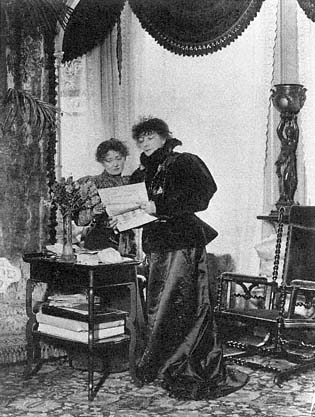
Figure 3.5
Sarah Bernhardt in her suite at the Hoffman House in
New York City, 1896. Among theater people, only
headliners could afford such expensive hotel homes.
lived in a hotel in New York's Greenwich Village when he came in the 1860s to edit the first Vanity Fair . Several writers made New York's Brevoort Hotel their home and through the 1880s mentioned life in the 100-room building in their novels. At New York's Majestic Hotel, at 72nd Street, another set of writers and artists congregated.[27] During two periods in her life, Willa Cather lived in a hotel: first, when she moved from Pittsburgh to New York City, and again in 1927, when building demolition forced Cather and Edith Lewis to move out of their apartment into the Grosvenor Hotel, at 35 Fifth Avenue. What they intended as a temporary refuge became their home for five years. Dylan Thomas and composer Virgil Thompson were only two out of many creative artists who made the Chelsea Hotel famous. Edna Ferber lived at the Sisson Hotel in Chicago. Nearer to the University of Chicago, Hannah Arendt and Thomas Mann each lived at the Windermere Hotel for part of their lives. Charlie Chaplin lived for a time in the Ambassador Hotel in Los Angeles, and for almost fifty years the Am-
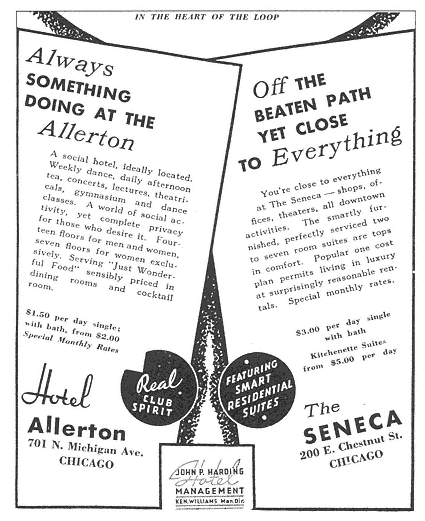
Figure 3.6
Advertisements for residential hotel life, 1936. Special monthly rates, social
activities, and good food were key promotional elements.
bassador was Walter Winchell's home.[28] The famous Round Table at New York's Algonquin Hotel met in the hotel dining room, but for the most part the members were not hotel residents.
Like most other downtown hotel residents, all types of creative artists thrived on hotel locations. These artists relied on and helped to support nearby restaurants, nightclubs, theaters, and other entertainments. A Gramercy Park hotel brochure in 1927 promised that its fortunate residents would "find themselves at the heart of the best New York can give."[29] Libraries, medical buildings, legal offices, and churches added to the downtown's convenience (fig. 3.6).
Retired and elderly middle-income tenants were also attracted to midpriced hotel life by the central access to recreation and downtown
services as well as the pedestrian independence hotels afforded. When the health of elderly hotel tenants waned, room service and hired nurses replaced their former independence. Throughout the history of inns and hotels, elderly people had been a proportion of the permanent residents.[30] Nonetheless, Sinclair Lewis's George Babbitt put retirement in a midpriced hotel in a dark light. Babbitt's in-laws had sold their house and moved to the Hotel Hatton in Zenith City, "that glorified boarding house filled with widows, red-plush furniture, and the sound of icewater pitchers." After a sad and soggy Sunday dinner, the Babbitts had to sit, "polite and restrained, in the hotel lounge, while a young woman violinist played songs from the German via Broadway."[31] Hayner's Chicago study gives the more positive example of the retired Martin couple, who had lived for twenty-five years in their own house in a small Illinois city and then for twenty-one years in various Chicago apartments. When their daughter married, the Martins moved to a hotel where they had often dined. Both of the Martins enjoyed dancing at the hotel. Mrs. Martin, an active woman in her late sixties, loved to be in the center of things and reveled in a crowd. When she was not in her room sewing for her nieces she was out shopping in the Loop.[32]
Not all hotel keepers wanted elderly tenants, healthy or not. "A nice old lady is nice," Ford said about elderly guests in his large midpriced hotel in New York, "but the average old lady is a troublesome boarder." Ford did not mention elderly men, but he continued, "When old ladies come to stay I don't try hard to cater to them. They go away. There's one hotel in town where most of them land."[33] Indeed, each city had several midpriced hotels with derogatory nicknames like "The Old People's Home" and coffee shops called "wrinkle rooms," even though no more than half of the residents at those hotels may have been elderly. Not all hotel residents were in such places. Kate Smith, for several years before her death in 1986, particularly liked to watch the ocean liners from her three-bedroom suite at the top of the Sheraton Motor Inn near the Hudson River and 42nd Street in New York.[34]
For all types of people, personal safety was a hotel attraction that many downtown apartment buildings could not match. Hotel desk clerks watched entrances around the clock; at intervals during the night, watchmen patrolled the halls checking for fire problems or situations amiss. When tenants had an emergency, staff were always on duty. People away from home overnight or for long periods of time
could leave with a sense that children, a spouse, or an elderly parent would be safer and have more readily available help than in a private home.[35]
Clearly, residents also came to live in midpriced hotels for emotional reasons as well as for practical and social advantages. The expanding local economies that helped to create jobs often meant an expanding supply of appropriate hotel buildings whose visual appeal, interior design, and gustatory delights helped to convince people to make the hotel their home.